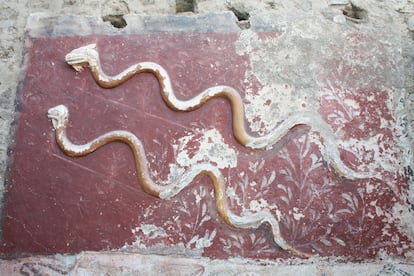Electoral inscriptions discovered in Pompeii reveal political patronage and corruption in ancient Rome
The signs found encourage voting for a certain Aulus Rustius Verus for the post of Aedile, the councilman in charge of public works

One autumn day in 79 A.D., Vesuvius’s fury stopped the clock in Pompeii and left the ancient Roman city frozen in time forever. Searching through the ashes, archaeologists working on the new batch of excavations have traveled back to the time before the volcano erupted and discovered some election inscriptions that prove that political maneuvering in antiquity was not unlike today; they have also found what was probably the last ritual offering to the gods before the devastating eruption. For researchers, the new discoveries are treasures that help figure out the details of what daily life was like in ancient Rome.
Inside a house, which has only partially been excavated, on the Via di Nola in the central area of ancient Pompeii, several electoral inscriptions — the ancient equivalent of today’s electoral posters and brochures — have appeared on the walls of the room that housed the lararium, the house’s domestic altar.
It was surprising to find these inscriptions inside the house, since they were normally put on the buildings’ exterior facades, where citizens could read the names and good attributes of the candidates for the city’s courts.
Archaeologists explain that the electoral ad was inside the house because it was common practice to organize events and dinners inside the homes of the candidates and their friends to promote their electoral campaigns.
In this case, the signs encourage voting for a certain Aulus Rustius Verus for the post of aedile, a kind of councilor who was responsible for public works in ancient Rome. This figure appears in other inscriptions and is known in Pompeii for having held the city’s highest public office, duoviri — the position to which one acceded after having been an aedile — in the 70s of the first century A.D. In ancient Rome, duoviri were magistrates who were elected in pairs so that they could control and advise each other, as well as supervise the city’s public, political and administrative offices. Aulus Rustius Verus held the position along with Giulio Polybius, who owned a splendid house on the Avenue of Plenty. Consequently, archaeologists deduce that the newly discovered inscriptions are older and that Aulus Rustius Verus probably won the elections mentioned in them.

Apparently, the house belonged to an Aulus Rustius supporter, perhaps one of his freedmen or a friend, and it contains a detail of note for archaeologists: a bakery with a large oven, near which the bodies of three victims, two women and a child, who were killed by the attic’s collapse during the first phase of eruption. The remains were discovered just a few months ago.
According to experts, the bakery’s presence reveals that political patronage — which, like today, consisted of promising favors in exchange for votes — was the order of the day in antiquity.
Maria Chiara Scappaticcio, a professor of Latin at the Federico II University in Naples, Italy, and the co-author of the study in which the new findings appear, explained that councilors and bakers “collaborated to the limits of legality,” and that Aulus Rustius Verus “could have realized very early on, when he was still in the midst of the election campaign to become a councilor, that, above all, the voter lives on bread.”
The discovery of the candidate’s initials, A.R.V., on a volcanic millstone leaning against the house entrance hall, where renovation work was being performed at the time of the eruption, supports that thesis. “Aulus Rustius Verus probably financed the bakery’s activity directly, both for economic and political purposes,” Maria Chiara Scappaticcio noted.
In addition, the remains of a last votive offering were found on the altar of the great lararium, which was decorated with two stucco snakes; the offering was probably made shortly before the eruption. Researchers have analyzed the remnants and discovered that the ritual consisted of offering figs and dates that were burned in front of the altar. To bring the rite to a close, a whole egg was placed directly on the lararium’s masonry altar. The altar was then covered with a tile. The remnants of earlier offerings were also found; they included fruits of the vine, fish and mammal meat.
The director of the Pompeii Archaeological Park, Gabriel Zuchtriegel, emphasized that each new archaeological find is shared practically in real time, through an electronic diary that they publish on the park’s website, as the excavation phase continues. “To my knowledge, we are the world’s first archaeological site to practice this form of scientific transparency: we are convinced that, in this way, Pompeii will be an international model for a new type of data accessibility because of the opportunities that digital technologies offer. The future of archaeology is here,” he said.
Sign up for our weekly newsletter to get more English-language news coverage from EL PAÍS USA Edition
Tu suscripción se está usando en otro dispositivo
¿Quieres añadir otro usuario a tu suscripción?
Si continúas leyendo en este dispositivo, no se podrá leer en el otro.
FlechaTu suscripción se está usando en otro dispositivo y solo puedes acceder a EL PAÍS desde un dispositivo a la vez.
Si quieres compartir tu cuenta, cambia tu suscripción a la modalidad Premium, así podrás añadir otro usuario. Cada uno accederá con su propia cuenta de email, lo que os permitirá personalizar vuestra experiencia en EL PAÍS.
¿Tienes una suscripción de empresa? Accede aquí para contratar más cuentas.
En el caso de no saber quién está usando tu cuenta, te recomendamos cambiar tu contraseña aquí.
Si decides continuar compartiendo tu cuenta, este mensaje se mostrará en tu dispositivo y en el de la otra persona que está usando tu cuenta de forma indefinida, afectando a tu experiencia de lectura. Puedes consultar aquí los términos y condiciones de la suscripción digital.
More information
Archived In
Últimas noticias
David Bowie, the galactic thinker who encouraged us to break new ground
John Berger and the loss of rural culture
From police officer to bloodthirsty kidnapper: Terror in Mexico during the years of ‘The Ear Chopper’
Alain Aspect, Nobel laureate in physics: ‘Einstein was so smart that he would have had to recognize quantum entanglement’
Most viewed
- David King, chemist: ‘There are scientists studying how to cool the planet; nobody should stop these experiments from happening’
- Reinhard Genzel, Nobel laureate in physics: ‘One-minute videos will never give you the truth’
- Oona Chaplin: ‘I told James Cameron that I was living in a treehouse and starting a permaculture project with a friend’
- Sinaloa Cartel war is taking its toll on Los Chapitos
- Mexico completes its trade shift with the entry into force of tariffs on China and countries without trade agreements











































